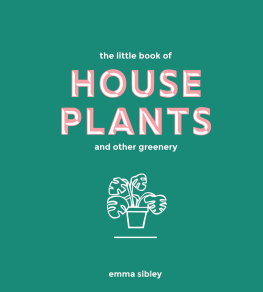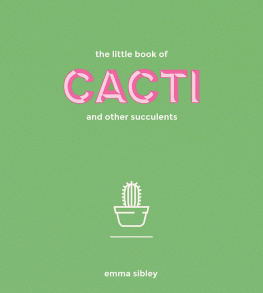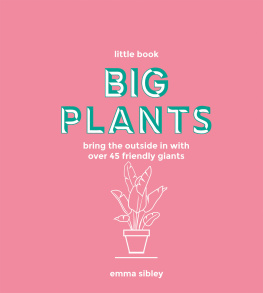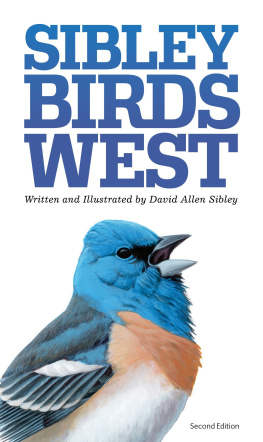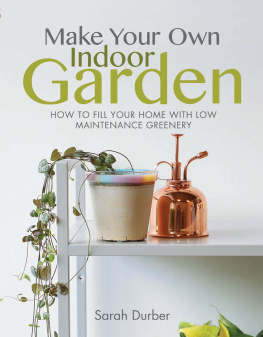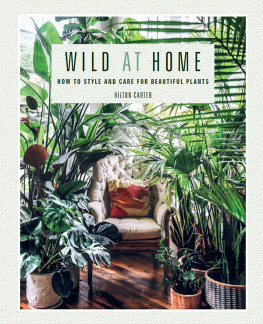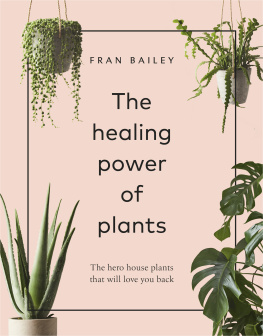I would love to dedicate this book to my grandparents, Ben and Ethel Howard, for passing on their green fingers to me.
CONTENTS

PLANTS FOR THE HOME

House plants are having their time at the moment. Whether it is a small collection of potted window plants or a larger stand-alone piece, any home can benefit from the addition of house plants. Surrounding yourself with greenery is not only known to help lift your mood, inspire ideas and create a sense of calm, but plants also purify the air around you by reducing airborne dust particles and removing pollutants.
Today, there are so many house plants available, from the various patterned leaves of a Calathea to the pancake-leaf shape of the Pilea or the deeply cut-out Monstera youre spoilt for choice.
With such a variety of plants available to purchase and expand your house plant family, it can be tricky to give each plant the exact care that it needs in order to thrive in your home. This book will help you nurture and care for your individual plants, explaining when and how to water, how much sun is needed and how to propagate each plant in order to grow or share your collection.
HOW TO USE THIS BOOK
Each entry includes key information about caring for that particular plant. All the information is clearly organised under appropriate symbols which will help you give your plants everything they need to grow and thrive.
KEY TO SYMBOLS
 | LIGHT |
 | WATER |
 | GROWTH AND CARE |
 | POTTING |
 | REPOTTING |
 | PRUNING |
 | PROPAGATION |
 | WATCH OUT FOR |
 | DID YOU KNOW |
 | HUMIDITY |
 | TEMPERATURE |
Each plant is given its common and Latin names; occasionally these are the same. The Latin or botanical name provides information about the relationship between plants and is known as the taxonomic status. All plants belong to a particular family and these are divided into genera (the plural of genus). The Latin name of each plant consists of two words: the genus and the species. The genus is a collective name for a group of plants, and the species (or specific epithet) tells you more about a particular plant.
When it comes to purchasing the right plant it is best to do it in person. There are a few online retailers now that can post plants straight to your door, but as convenient as this can be I think it is best to visit your local nursery, garden centre or plant shop where you will be able to pick out what you want from the selection and chat to the people who work there to make sure you are getting the right plant for your home.
When you have chosen your plant, now is the time to check for any signs of disease (browning leaves or yellow dots) or visible pests, as you do not want a diseased plant or to risk affecting the rest of your collection.
Buying house plants can be addictive. You never seem to have enough and there is always room for one more! You will find plants that like to sit next to each other: ferns and Calathea can be friends because they both like high humidity so will enjoy a good misting, and Begonias do not like getting too much water on their leaves, so will benefit from being placed away from the ferns.
Use your hanging and trailing plants to break up your bookshelf or display them from a ceiling hook. It is always important to give each plant enough room to grow, as you dont want the aerial roots from your giant Monstera to start creeping into the pots of your smaller plants, others such as the Paper Plant like plenty of room to extend their long arms without obstruction. A large collection is great but make sure you have the correct space and enough light to keep everyone happy!
ESSENTIAL EQUIPMENT
CONTAINERS AND OTHER TOOLS
Most plants you bring home will come in plastic or terracotta pots. These will need to be placed inside another decorative pot without a hole, so the plastic pot can drain through, or you can use a plastic dish under the original pot. It is always useful to have a trowel and a sturdy pair of gardening gloves handy for mixing soil and repotting plants.
COMPOST
For most house plants a general potting or multipurpose compost will be sufficient. Use organic compost if you want to avoid insecticides.
WATERING
A small watering can and mister is essential to keep humidity high and your plants hydrated.
SNIPS
It is a good idea to get yourself a small pair of snips. These will be very helpful when pruning and propagating your house plants.
ADDING HUMIDITY TO YOUR COLLECTION
Many house plants require a high humidity in order to flourish. Unfortunately due to city life and central heating most environments in the home are very dry and you will need to alter the humidity in the surrounding environment.
MISTING
As much as you water a plant this will not help with the humidity, so you will need to mist the surrounding air and leaves to increase this. However, double check specific plants as some require a high humidity but do not like water gathering on their leaves, so another method may be better for them.
PEBBLE TRAY
Grouping plants together on a pebble tray filled with water can be beneficial to plants that do not appreciate water on their leaves. The pebbles ensure that the plants do not take up excess water, which can lead to root rot, so as the water evaporates from the tray it creates a high humidity, which will get trapped between the leaves of the plants.
THE PROCESS OF CREATING NEW PLANTS FROM A CUTTING, AN OFF SET OR A SEED.

Propagation is the process of creating new plants from a cutting or by separating the plant at the repotting stage. You can also propagate plants from seed, but this is a lengthier process, so we are just going to concentrate on the first two methods.

